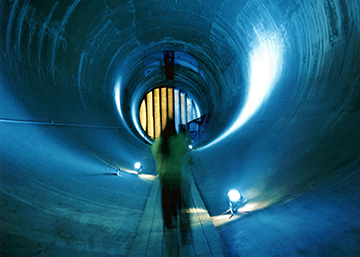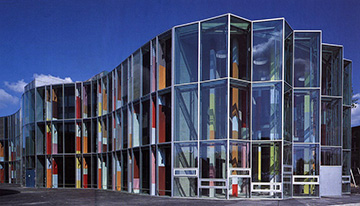![]()
Light installation at Adlershof. [Image: © WISTA Management GmbH]
On the outskirts of Berlin lies Germany’s small-but-mighty “science city,” Adlershof. Occupying just four square kilometers of land, Adlershof is home to more than 1,100 companies and scientific research institutions, a significant portion of them with an optical bent. Over 20,000 people work in Adlershof, along with more than 6,000 students who attend the six natural science institutes on Humboldt University’s Adlershof campus.
For decades, Adlershof’s developers have intentionally shaped it to foster cooperation between academia and industry and to encourage the translation of research into commercial products. Their aim has been to represent the entire value chain, from the initial idea to the final product, to create a sustainable innovation nexus. To learn more about the model’s roots and how it’s working, OPN talked with several academic and industry sources in the science city.
First in flight

Inside a wind tunnel at the German Research Institute for Aviation. [Image: © WISTA Management GmbH]
Adlershof stands on the site of Germany’s very first airfield; the name loosely translates to “eagle’s yard.” Germany’s aviation headquarters had set up shop in Adlershof by 1912, and the site’s aviation roots are still present today, albeit with a more modern focus on space exploration. “If you’ve ever seen a picture from Mars,” says Bernd Ludwig, head of the Center for Photonics and Optics at Adlershof, “they were taken by a 3D camera which was invented here in Adlershof at the German Aerospace Center.”
However, Adlershof is no longer a testbed for aviation designs. After going through several iterations as the eastern Berlin research hub adapted to the geopolitical shifts of the 20th century, Adlershof was restructured again during German reunification in the early 1990s. Some of Adlershof’s academic institutes, which had previously been under Soviet control, were officially integrated into the broader German research landscape. But what about the remaining 80% of Adlershof’s workforce? Rather than leave, many decided to stay—and to accept incentives to start companies.
These relationships between the earliest companies at Adlershof and the research institutes there are “actually the core and the origin of Adlershof as we see it here today,” says Frank Lerch, director of OpTecBB—an optics industry networking association in Adlershof. “Many established companies, such as Sentech, actually come from that time,” says Lerch, “and people still talk to each other.”
Collaboration = innovation

The Center for Photonics and Optics. [Image: © WISTA Management GmbH]
The lasting relationships between companies, research institutes and universities have helped to build Adlershof into a major destination for optics and photonics during the intervening decades. The Center for Photonics and Optics is one of five major technology centers co-located in Adlershof, housing dozens of optics companies as well as major optics research institutes, such as the Max Born Institute for Nonlinear Optics and Short Pulse Spectroscopy and the Ferdinand-Braun-Institut.
In addition, Humboldt University’s Adlershof campus features an international optical sciences Master’s program. “Many of these students go on to complete their Ph.D. theses at these research institutions,” says Kurt Busch, professor of theoretical optics and photonics at Humboldt University and group leader at the Max Born Institute. “Everyone wins.”
Not only do the students gain from this arrangement, but their professors reap benefits as well. “By adding additional resources to top professorships, through access to labs and fabrication technologies, for example, that perhaps Humboldt couldn’t provide alone,” explains Busch, “the strong interactions between the university and the institutions make it much more attractive to come here.”
This synergistic spirit has another huge upside—funding. According to Busch, Adlershof’s agglomerated setup allows for collaborators to reach the necessary “critical mass” to receive funding. “It’s about trust,” he says. “There are many instances where it is clear that additional resources or expertise will lead to a win-win situation, and that's why the collaborative spirit is very strong.”
Most important, this symbiosis sparks innovation. “People meet, and they talk, and they just cross-fertilize ideas,” says Ludwig. “They have common challenges, so they sometimes try to solve them together. This environment supports them.” This approach has been successful in the past. In one joint effort, PicoQuant—an optical instruments company—joined forces with the nano-optics group at Humboldt University to develop a physical quantum random-number generator.
Tackling the world’s grand challenges
As for the future, says Ludwig, “the goal is solving the grand challenges of the world.” Two such grand challenges that Adlershof’s optics community is focusing on are clean energy and the environmental impact of CO2. One company, Home Power Solutions, is working toward making homes energy independent by making photovoltaic energy as available in winter as it is in summer. Another company, Graforce Hydro, has developed a process called plasmalysis that breaks down industrial wastewater into oxygen and hydrogen, thereby generating efficient fuel as well as reducing emissions.
Also on the horizon, the long awaited new Berlin Brandenburg Airport, only a 15-minute drive from Adlershof, is slated to open in October 2020. That development should be followed by a new lecture space at Humboldt University within the next five years. With these two advances, says Busch, Adlershof would be poised to host major scientific conferences on its grounds, which would “hopefully bolster the visibility of Adlershof as a whole.”
